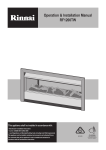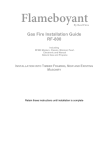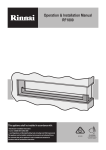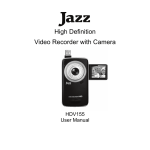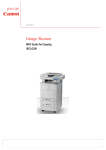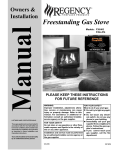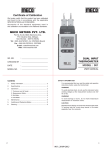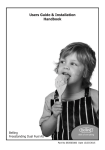Download Real Fires RF800 Installation manual
Transcript
Operation & Installation Manual RF800 This appliance shall be installed in accordance with: • Manufacturer’s Installation Instructions • Current AS/NZS 5601 AS/NZS 3000 • Local Regulations and Municipal Building Codes including local OH&S requirements This appliance must be installed, maintained and removed by an Authorised Person. For continued safety of this appliance it must be installed and maintained in accordance with the manufacturers instructions. All Rinnai gas products are A.G.A. certified. Congratulations on the purchase of your RF800 Decorative Gas Log Effect appliance We trust you will have many years of enjoyment from your purchase. THIS MANUAL CONTAINS IMPORTANT INFORMATION. FOR SAFETY PLEASE READ CAREFULLY BEFORE PROCEEDING WITH ASSEMBLY, INSTALLATION AND OPERATION OF YOUR NEW FLAME FIRE AND GAIN A FULL UNDERSTANDING OF THE APPLIANCE. Rinnai i RF800 OIM OPERATION TABLE OF CONTENTS Before You Start 2 Safety3 Safety Devices 4 Features5 Control Panel Operation 5 Remote Control Operation 6 Operational Safety 6 Burner Media 7 Power Failure 7 Cleaning7 When to call for Service 7 Service7 Installation Table of Contents 9 Contacts26 Rinnai 1 RF800 OIM BEFORE YOU START INSTALLATION REQUIREMENTS This appliance MUST BE installed by an authorised person. The installation MUST conform to local regulations. The installation MUST also comply with the instructions supplied by Rinnai. Service and removal MUST BE carried out by an authorised person. CERTIFICATION The Rinnai RF800 has been certified by the Australian Gas Association. The Certification Number is shown on the appliance dataplate. No parts or functions are to be modified or permanently removed from the heater. Please keep these instructions in a safe place for future reference. CARTON CONTENTS The components for RF800 heater are supplied in separate cartons, the following table lists which components are in each carton. Ensure that the components listed for the installation method being installed are present before proceeding with the installation. A B 1 2 6 5 7 (3 sided trim shown) 3 4 Item 8 Description 1 Rinnai RF800 gas fire engine 2 Side reflector panels 3 Remote control (batteries supplied) 4 This operation and installation manual 5 Gas connection kit: 200mm 3/8 Flexi tube with plug and 3/8” - 1/2” reducing flare connector 6 Coal location rail (not used for pebbles or crystal installations) 7 Trim & hangers - 3 or 4 sided / Black or Stainless Steel 8 Burner media - Logs and Coals or Pebbles * C Carton A B C ● ● ● ● ● ● ● ● * Log and coal set includes; 31 coals, 2 logs, 3 twigs, approx 120gms of granules - all parts are ceramic. Rinnai 2 RF800 OIM SAFETY WARNING DO NOT OPERATE THIS APPLIANCE WITHOUT READING AND UNDERSTANDING THESE INSTRUCTIONS. Taking time to familiarise yourself with the appliance’s features and operation will allow you to get the most out of your appliance for years to come. Please keep these instructions for future reference. Failure to comply with these instructions could result in a fire or explosion, which could cause serious injury, death or property damage. Improper installation, adjustments, service or maintenance can cause serious injury, death or property damage. Such work must be performed by authorised personnel. The appliance must be installed in accordance with the local gas and electrical authority regulations. Flue terminal must always vent directly to outdoors. DO NOT extend the flue vertically or horizontally in ways other than prescribed in the appliance manufacturers’ installation instructions. For information on gas consumption, see data plate on the appliance. This appliance must not be installed where curtains or other combustible materials could come into contact with it. In some cases curtains may need restraining. When considering installation ensure minimum clearances as in the adjacent drawing are adhered to: m Mi in 0m m n M m m 00 10 This appliance is not intended for use by persons (including children) with reduced physical, sensory or mental capabilities or lack of experience and knowledge, unless they have been given supervision or instruction concerning use of the appliance by a person responsible for their safety. 300m 75 Heat radiating from the front of this heater may over time affect the appearance of some materials used for flooring such as carpet, vinyl, cork or timber. This effect may be amplified if the air in the room contains contaminants like cooking vapours or cigarette smoke. To avoid this possibility, it is recommended that a mat or similar protective sheet be placed in front of the appliance, extending at least 750 mm in front of the appliance fascia. The appliance is not intended for use by young children or infirm persons without supervision. Young Children must be supervised when in the vicinity of this heater while it is in operation. For protection of young children or the infirm a secondary guard is required. If the supply cord is damaged or requires replacing, it must be replaced by the manufacturer or the manufacturer’s agent or similarly qualified person in order to avoid a hazard. DO NOT connect to an LPG Gas cylinder indoors. A dedicated 240 V earthed 10 Amp power point must be used with this appliance. DO NOT modify this appliance. Modifying from original specifications may create a dangerous situation and will void your warranty. ONLY THE FLUE COMPONENTS SPECIFIED BY RINNAI MUST BE USED. Unpack the heater and check for damage. DO NOT INSTALL A DAMAGED HEATER. If the heater is damaged, contact your supplier for advice. Before installing the heater, check the label for the correct gas type (refer rating plate, inside the appliance). Refer to local gas authority for confirmation of the gas type if you are in doubt. Rinnai 3 RF800 OIM SAFETY DO NOT sit or lean against the heater. IMPORTANT DO NOT allow children or elderly persons to sleep in the warm air discharge from the heater. DO NOT post or allow children to post articles into the louvres of the heater. DO NOT cover or place articles on this heater. DO NOT place articles in front of the louvres. DO NOT operate / install this heater in areas where painting is taking place, or in places such as hairdressing salons, where there may be fluff and dust, and where aerosols are used. DO NOT place articles on or against this appliance. DO NOT use or store flammable materials near this appliance. Keep flammable materials away from heater. Combustible materials MUST NOT be placed where the heater could ignite them. DO NOT spray aerosols in the vicinity of this appliance while it is in operation. Most aerosols contain flammable substances which can be a hazard if used near this appliance when it is in use. DO NOT use power boards or double adaptors to operate this appliance. The heater MUST NOT be located below a power socket-outlet. DO NOT place containers of liquid on top of the heater. Water spillage can cause extensive damage to the appliance and create an electrocution hazard. DO NOT CONNECT TO AN LPG GAS CYLINDER INDOORS. Turn the heater ‘OFF’ when not in use. DO NOT unplug the heater while it is in operation or while the fan is still cycling. When the heater is operated for the first time or after long periods of non use a slight odour may be emitted, this is normal. However if odours persist switch ‘OFF’ the appliance and contact Rinnai. Appliances incorporating a live fuel effect and designed to operate with luminous flames, may exhibit slight carbon deposits. This is primarily a decorative appliance and has not been designed as a space heater. NOT INTENDED FOR FIREPLACE INSERT WHAT TO DO IF YOU SMELL GAS DO NOT try to light any appliances. DO NOT touch any electrical switches: do not use any phone in your building Immediately close the shut-off valve at the gas meter or bottles Call an authorised service technician SAFETY DEVICES Electrical Fuse: The electrical circuits are protected by a fuse. Flame Failure Sensing System: This device automatically cuts off the gas supply to the heater in the event of a flame failure. Power Failure: In the event of a power failure or power cut, the gas valves will automatically close. Rinnai 4 RF800 OIM FEATURES Hot Air Outlet Louvre Outer Trim Reflectors Burner Media (Logs, Coals/ Pebbles/ Glass) Front Panel Control Panel Air Intake CONTROL PANEL OPERATION To operate your appliance for the first time, ensure that the gas supply is on and that the appliance has been tested and commissioned by an authorised installer. Switch on the power supply to the appliance (This is usually a wall switch near to the appliance). ON/OFF Button Operation LED The appliance can now be started by using either the Control Panel or the Remote Control. Ignition Start the appliance by pressing the ON/OFF button for at least one second until the red light on the control panel comes on. NOTE Remote Receiver Window If the appliance has not been used for some time then the gas may take some time to ignite as the gas in the pipes may need to purge. The appliance will try to start for up to one minute before “locking out”. If this happens, then press the ON/OFF button twice to re-set then re-start the appliance. If the appliance has not started after 3 attempts, contact the installer or an authorised service person. Always run the appliance on high for at least a few minutes to ensure a quick warming up of the firebox and flue. NOTE The appliance will start on the same flame setting it was last used at unless the mains power supply has been disrupted or disconnected, whereby the default flame setting is reset to low. To ensure a high setting, during ignition press the flame control + button for up to 10 seconds (refer to the remote control operation on page 6 for flame control details). Once the Pilot has ignited, then gas will begin to flow to the main burner. The flame picture should be right across the burner within about 10 seconds. If the burner does not light or only lights part way across then turn the appliance off immediately and call an authorised service technician for further advice. Turning Off The appliance can be stopped by pressing the ON/OFF button on the Control Panel or by pressing the power button on the remote control (refer to the remote control operation on page 6 for details). The flames may take a few seconds to fully extinguish. This is normal and is not a cause for concern. Rinnai 5 RF800 OIM REMOTE CONTROL OPERATION NOTE Here are a few things you should know about your remote control to keep it working at its best: The remote uses 4 AAA batteries, and has a range of about 8 metres with fresh batteries. When replacing the batteries, replace all 4, DO NOT mix old with new. Remove the batteries if the appliance is not going to be used for extended periods. Some fluorescent lights can affect the performance of the remote. Avoid dropping the remote or getting it wet. • • • • • Ignition Point the remote control towards the appliance and press the power button for at least 1 second. The appliance will then commence the ignition sequence. Always run the appliance on high for at least a few minutes to ensure a quick warming up of the firebox and flue. The flame can then be turned down if so desired. NOTE The appliance will start on the same flame setting it was last used at unless the mains power supply has been disrupted or disconnected, whereby the default flame setting is reset to low. To ensure a high setting, during ignition press the flame control + button for up to 10 seconds. Flame Control Press the flame control + button to increase the fame or the flame control button to decrease the flame. Fan Control The appliance has a two speed fan. Press the fan control + or the fan control - buttons to switch the fan to High, Low or Off. Power Turning Off Flame Control To switch the appliance off, press the power button on the remote control. Auto Off Timer By pressing the auto off timer button on the remote control the appliance can be set whilst in operation for a 30 minute delayed switch off. The red indicator light on the front panel of the appliance will flash when this mode has been activated. Pressing the auto timer button a second time will cancel this mode. Fan Control Auto Off/ Cancel OPERATIONAL SAFETY This appliance is factory tested and the installation MUST BE tested by an authorised installer. You should not experience any odour from your appliance other than initial burn off smell the first time it is used. Should any odour persist after the initial burn in, turn off the gas supply and arrange for an authorised person to make a service call. This appliance has a flame failure safety system which ensures that in the event of an ignition failure, gas supply failure or flame being extinguished for any reason, the appliance will shut down. The appliance will attempt to restart automatically. LOCK OUT If the appliance fails to re-ignite then the appliance will “lock out” and will need to be re-set manually by pressing the ON/OFF button twice to re-set and re-start the ignition sequence. Wait at least 10 seconds before re-starting the appliance and if the appliance fails to ignite after 3 attempts then turn off the power and refer to the trouble shooting section on page 22. NOTE This appliance burns with a real flame and as such there are considerations to be made to ensure the safety of children and the infirm. In such circumstances a fire guard should be secured in front of the appliance. Furniture and other objects must not be placed within 1 metre of the fireplace. Make sure that the lower and upper air inlets are not blocked as this could cause damage to the fan or cause the gas controls to overheat. Rinnai 6 RF800 OIM BURNER MEDIA The burner media MUST BE positioned correctly by the installer. It is not intended that these are re-positioned by the user. Incorrect positioning can affect heat output and ignition. ONLY burner media supplied by the manufacturer may be used in this appliance. Due to the nature of luminous flames used in this appliance, a slight build up of carbon (soot) may be seen. This is quite normal and will not affect the performance of the appliance. POWER FAILURE In the event of a power failure, your appliance cannot be operated. CLEANING Regular cleaning of your appliance is important to keep it looking its best. Some points on cleaning: •All of the exterior painted panels can be cleaned using household cleaners. black interior panels and the burner media may develop a slight build up of soot, this is quite normal and •The might burn off over time. Do not try to remove the soot by rubbing with a cloth as this will only spread the soot around. not vacuum the burner media, especially the Log & coal bed, any reduction or modification of the burner •Do media installed can effect the performance and or damage the appliance. •The stainless steel reflectors and front panel (if fitted) can be cleaned using a household stainless steel cleaner. WHEN TO CALL FOR SERVICE There are a few things to look out for that could indicate that your appliance requires a service call. streaky flames are touching the top of the firebox, this can cause the paint to blister and possibly damage •Ifthelong appliance. •If you can smell gas, regardless of whether the appliance is going or not. NOTE There can be a brief smell of gas as the appliance is going through the ignition sequence, however this should soon stop once the appliance has started. Abnormal Flame Pattern •If the pilot flame looks abnormal. Signs of abnormal pilot operation could be: A very short flame that does not reach across to the flame rod. A very long flame that reaches far beyond the flame rod or long yellow flames. A roaring noise when the pilot is operating or the flame “lifting off” from the pilot head. •If there are large soot deposits that keep building up on the burner media. is excessive noise or explosive ignition as the burner lights, this could •Ifbethere due to blocked burner ports. a smell of flue gas continues after the appliance has been operating for at •Ifleast 10 minutes. This could indicate a blocked flue or other problem. This smell is acceptable during the first few minutes as the flue heats up and starts to draw. the flames change shape or colour. When the appliance first starts the •Ifflames will tend to be quite blue for a few minutes but will change to a more yellow/orange colour as the system heats up, this is normal, but if the flames either stay very blue, or turn a dark , streaky orange colour, this could indicate a problem. Contact Rinnai for advice. SERVICE In order for your appliance to give years of comfort and enjoyment, it is recommend that it is serviced on an annual basis by a licensed service gas fitter. Please refer to the back of this manual for contact details. Rinnai 7 RF800 OIM This page is intentionally blank Rinnai 8 RF800 OIM INSTALLATION TABLE OF CONTENTS Operation Table of Contents 1 Installation Safety 10 Specifications 11 Dimensions 11 Gas & Electrical Supplies 12 Clearances 12 Mantles, Surrounds, Recesses & Hearths 13 Ventilation 14 Flue Requirements 14 Engine Installation 15 Masonry Cavity Design 16 Appliance Gas Connection & Commissioning 18 Aeration Sleeve Details 19 Pilot Burner Performance 20 Trim Installation 20 Burner Media Installation 21 Final Checks 22 Trouble Shooting 22 Commissioning Checklist 22 Wiring Diagram 23 Installation Notes 24 Contacts26 Rinnai 9 RF800 OIM INSTALLATION SAFETY WARNING This appliance must be installed by a suitably qualified person in accordance with local codes and AS/NZS 5601 This is primarily a decorative appliance and has not been designed as a space heater This appliance has been tested to AS 4558 DO NOT operate this appliance without reading and understanding these instructions first This appliance is designed for installation into a timber framed construction and new or existing masonry installations NOT INTENDED FOR FIREPLACE INSERT Only the approved flue componenets specified by Rinnai MUST BE used This appliance must be installed into a well ventilated room in accordance with AS/NZS 5601 This appliance is designed for indoor installation only; NOT TO BE INSTALLED OUTDOORS Rinnai is not responsible for incorrect or improper installations All installations must be carried out by authorised personnel Be sure to complete the installer details section of the user guide before signing off the installation DO NOT place articles on or against this appliance DO NOT store chemicals or flammable materials, or spray aerosols near this appliance DO NOT operate with panels, covers or guards removed from this appliance DO NOT modify this appliance Rinnai10 RF800 OIM SPECIFICATIONS Models:RF800E(N/P) Burner Media: Ceramic Logs / Coals and Granules Ceramic Pebbles Gas Types:Natural Gas Propane Gas Description: Indoor Decorative Fire Flue: 200 mm stainless steel inner/ 250 mm galvanised steel outer 200mm Flexi liner (masonry only) Minimum of 2.4 metres of flue, 3.6 metres if off-set bends are used Flue Cowl: AGA Approved 200 mm Flue Cowl Gas Connection: 3/8” BSPF Gas Flare onto gas control Power: 230/240V a.c. 50hz, 1 Amp Fan:Tangential; 2 speed Burner: Bunsen type atmospheric Gas Control: SIT 845 with SIT 579. DBC modulating control Ignition:Electronic Flame Monitoring: Flame rod Control: Electronic control with IR remote control NOTE For all other specifications refer to the appliance data plate. DIMENSIONS Engine Trim 870 15 378 * 605 410 375 ** 800 ** 230 583 552 ** 600 900 910 * APPROXIMATE DEPENDS ON BENDS ** FOR MASONRY INSTALLATIONS ONLY Rinnai11 RF800 OIM GAS & ELECTRICAL SUPPLIES Gas Supply A suitable gas supply needs to be provided to the left hand rear corner of the installation cavity prior to installing the appliance. The pipe sizing should be calculated to supply at least 40MJ/h Allow sufficient pipe to make the connection as shown right. NOTE The gas inlet access point for this appliance is provided with a set folding flaps to allow piping with fittings attached to be passed through for connection. For vermin control ensure that these flaps are closed again once the piping has been installed. Use the supplied gas connection kit (200mm 3/8 Flexi tube with plug and 3/8” - 1/2” reducing flare connector) to connect the appliance to the consumer piping. Electrical Supply 350 155* 261* approximate 108 This supply is used to isolate all power from appliance. The power cord is designed for a 230/240V AC 10 amp supply. 117 The appliance is supplied with a power lead approximately 1.8m long. This needs to be connected to an isolating wall socket within the cavity and connected to an isolating wall switch, preferably located to the right of the appliance, facing into the room, not inside the framing cavity. Electrical connections must be in accordance with AS/NZS 3000 and installed by an authorised person. * From finished wall lining 305 approximate CLEARANCES 300m m Mi n 10 00 m m M 75 in 0m m The appliance must be installed with the shown minimum clearances to combustible materials. See also “Mantles, Surrounds, Recesses & Hearths” on page 13 for additional information. Rinnai12 RF800 OIM MANTLES, SURROUNDS, RECESSES & HEARTHS Mantles 45° A timber mantle may be installed above this appliance but must be within the grey area as shown here. X Timber Surrounds Mantle MANTLE MUST NOT EXTEND BEYOND THIS AREA X As with mantles when a timber surround is to be fitted, ensure it complies with minimum timber clearances of 300mm above and 150mm to each side. NOTE * NOTE THAT SIDE CLEARANCES CAN BE REDUCCED FROM 300MM TO 50MM 300* If the appliance is to be installed into a recess the recess must comply with the following limitations. Wall Recesses The same limitations apply to the sides of the appliance. Top Trim TV or Ornamentation Above The Heater CAUTION RECESS MUST NOT EXTEND BEYOND THIS AREA The installation of electrical appliances above and in the vicinity of the heater such as, but not limited to, Plasma TV, LCD TV, Home Theatre Screens, Speakers, etc must comply with their manufacturers’ instructions. It is the responsibility of the installer/ end-user to check the installation instructions of these items and to ensure the location is suitable. FIREPROOF BOARD FOR ANY WALL BELOW RECESS 45° FIREPROOF BOARD FOR MINIMUM HEIGHT OF 300 MM This caution also extends to, but is not limited to, ornaments such as: Paintings, Prints, Photographs, Tapestries, Mirrors, Stuffed Animals, etc. IDEA NOTE 100 FIREPROOF BOARD OR OTHER NON-COMBUSTIBLE MATERIAL WALL SIDE VIEW TRIM Use either a shelf or mantle below the TV or ornament or alternately you can construct a recess to mount TV or ornament on. Check the manufacturers installation instructions for these items and ensure the recess is suitable. Rinnai does not take any responsibility for any damage occurring to any items installed above and in the vicinity of the heater. Hearths Although a solid hearth is not required, if the appliance is to be installed within 300 mm of the floor, it is recommended that protection is given to any flooring surface directly in front of the unit. The appliance produces a large amount of radiant heat and this might cause damage to flooring and furnishings that are too close. 0 30 Rinnai13 RF800 OIM VENTILATION IMPORTANT This appliance is a decorative flame effect appliance, the space or room in which the unit is installed must have adequate fixed ventilation compliant with the requirements of AS/NZS 5601. For Decorative Gas Log Fires this requires that one or more openings with a combined free ventilation area of not less than 314 cm² shall be provided for each appliance. The opening may be provided by any of the following options, provided that there is a ventilation path to outside that is unobstructed by building material or insulation: a) Directly through an outside wall (preferred option). b) Through to an outside wall but offset. c) Into a cavity ventilated to outside. d) Into an underfloor space ventilated to outside. e) Into a roof space ventilated to outside. FLUE REQUIREMENTS IMPORTANT ONLY the Rinnai flue components described in this manual are to be used with this appliance. Direct Offset A A The installation of the flue system MUST comply with the requirements of AS/ NZS 5601. A Examples of available flue component configurations are shown right, the minimum flue heights are as follows: Direct Offset Extended Offset 2.4m 3.6m* 3.6m* Extended Offset A A B A B B B * Only 1 x RFBEND200 can be used on any Offset or Extended Offset flue installation. A RFBEND200 2x 45° twin skin bends ø 200mm inner / ø 250mm outer NOTE The assembled RFBEND200 dimensions shown right are approximate and are for reference purposes only. C. RFCOWL200 Connection ø 200mm Cowl outer ø 350mm Rinnai14 35 45° B 70 B. RFPIPE200 900mm twin skin flue pipe ø 200mm inner / ø 250mm outer (approx 855mm when installed) 357 A. 148 C Dimensions are approximate and are for reference purposes only. RF800 OIM ENGINE INSTALLATION Timber Cavity Design The appliance and flue need to be installed before the wall can be lined! DO NOT INSTALL THIS LINTEL UNTIL ENGINE AND FLUE ARE INSTALLED It is recommended that the cavity lintel is left off until the flue and engine have been installed (Allow approx 1200mm clearance above the engine). Remember that both gas and electricity are required within the cavity (see, “Gas & Electrical Supplies” on page 12). When engine installation is complete, the fitting of cardboard from the packaging material to the front flanges of the appliance with some low-tac masking tape will help to protect the appliance from dust, paint, etc. of subsequent construction drawing into the appliance. 595~600 IMPORTANT 25mm MIN CLEARANCE BETWEEN FLUE AND COMBUSTIBLES 880~ 900 M U ITY IM V IN CA M F m O 5m TH 3 4 EP D 368mm FROM FINISHED WALL FACE FIX TO APPLIANCE WITH SCREWS OR RIVITS (NOT SUPPLIED) Secure the appliance to framing using strapping provided with appropriate fixings (not supplied) as shown. It is recommended that the appliance be installed on a solid platform. If this is not possible then there must be support provided at the front and back of the cavity - no further back than 368mm. NOTE FIXING STRAP If the appliance is to be installed with a hearth, either on the floor or cantilevered, it is important that the finished top of the hearth is flush with the floor of the installation cavity. For the best finish, allow for the hearth to fit under the engine by 5~10 mm. 5~10mm FRONT OF FIRE TO EDGE OF HEARTH CAVITY BASE HEARTH HEARTH SUPPORT Rinnai15 WALL BOARD RF800 OIM MASONRY CAVITY DESIGN Remember that both gas and electricity are required within the cavity before the appliance is installed (see, “Gas & Electrical Supplies” on page 12). NOTE These instructions are for either new masonry/non combustible cavities or existing masonry fire places. A flexi flue and adaptor is available for installations where access is restricted. If the cavity can be completed after the engine and flue are installed then the adaptor might not be required. The flue adaptor can also be used with rigid flue where space allows. The flue should be self supporting before the engine is installed. This appliance is not designed for installation without a dedicated flue liner. 200 SINGLE SKIN FLEXI FLUE LINER ~90 0 FLEXI FLUE AND ADAPTOR ~90 0 575~595 805 400 MIN 552 TO UNDERSIDE OF SPIGOT 370 MIN 555~595 575~595 380 229 This appliance consists of a firebox and removable insulating panels. For masonry installations only, these panels can be removed if cavity space is restricted. Remove as few or as many panels as required. The more panels retained, the more efficient the appliance will be. IMPORTANT Take care not to damage the power cord when removing the back panel! Rinnai16 RF800 OIM Preparation of the Engine If the flexi flue adaptor is to be used then there are modifications that need to be made to the engine. 1. Remove the top insulating panel and insulation. 2. Remove the 4 screws holding the twin skin flue spigot in place and carefully remove the spigot. IMPORTANT DO NOT remove the white gasket. 3. Remove the six screws down the side of the spigot and attach the two spigot rails that are supplied with the flexi flue spigot 4. If the top insulation panel is to be used, then it must be cut to allow the spigot to transition down the rails. Each panel will end up being about 250mm wide 5. Remove the two knock-outs in the centre of the top flange of the engine INSULATION AND COVER SPIGOT RAILS SPIGOT GASKET 250 SPIGOT KNOCK OUTS Installing Engine 1. Place the engine onto the hearth and carefully line up the gas supply pipe with the hole in the back left hand corner of the engine 2. Make sure that the power supply cord is passed through the cavity for connection by a registered electrician. 3. Line the flue spigot adaptor up with the guide rails on the top of the engine and push the engine in. Take care not to roll the spigot gasket as the engine slides in! 4. Once the engine is fully home, use screws to hold the flue spigot to the top flange of the engine 5. Fix the front flange of the engine to the cavity. NOTE SPIGOT GASKET It is not necessary to seal the engine to the cavity. SPIGOT FIXING ENGINE FIXING Rinnai17 RF800 OIM APPLIANCE GAS CONNECTION & COMMISSIONING Once the engine has been installed and fixed to the building the gas and electricity can be connected. Some installers elect to leave this until the decorating has been completed and the installation can be finished, remember that the trim can not be attached until the wall lining is finished. CAUTION If commissioning is to be carried out after the decorating has been completed, leave a protective cardboard cover taped to the front of the engine using a low-tack tape to prevent plaster dust and debris from entering the engine and damaging the paint work. Isolate the power and gas supplies before commencing work on the appliance. Gas Connection 1. Remove the front panels and strip all the protective plastic film from this item. 2. Remove the Air Diverter Panel from the front of the Burner Assembly. 3. Remove the burner assembly by removing the two fixing screws in front of the burner and pulling the tray forward and then upwards to remove from the gas control. 4. There may be aeration sleeves attached to the venturi tubes on the back of the burner, take care not to lose these, there is a chart on page 19 that shows which aeration sleeve should be used depending on the gas and burner media being used. BURNER FIXING SCREWS BURNER ASSEMBLY GAS CONTROL FIXING SCREWS CONTROL PANEL AIR DIVERTER PANEL CONTROL LEAD 5. After bending and flaring the gas supply pipe, purge the gas pipe and fix the gas control assembly back in place and connect the gas. 6. Reconnect the power and gas (reconnect the control panel and fan connection if previously removed). 7. Replace and fix the burner assembly in place. Gas Commissioning 240 VOLTS, RISK OF ELECTRICAL SHOCK! WARNING When performing the commissioning, the appliance electrical power will need to be connected. Exercise CAUTION as there is potential for electric shock from the exposed wiring and circuitry. DO NOT leave the appliance unattended when power is connected and the panels are removed. Installation and commissioning must be carried out by an authorised person. Wiring inside this appliance may be at 240V potential. DO NOT test for gas escapes with an open flame. GAS PRESSURES NOTE Refer to the appliance data plate located inside the appliance on a swing tag for correct gas pressure settings. 1. Using a suitable screw driver loosen the captive Appliance Test Point Pressure (ATPP) screw D and fit the manometer, (an electronic manometer is recommended). Refer images for ATPP location. 2. Remove the dust cap C from the regulator adjusting screws. 3. High Pressure Setting: Turn the appliance ‘ON’ and adjust to the highest setting, see “Remote Control Operation” on page 6. Use a 10 mm spanner to turn nut A , lock screw B with appropriate screw driver to prevent it turning. Turning nut A clockwise increases the outlet pressure whilst turning anti-clockwise decreases the outlet pressure. Rinnai18 RF800 OIM 4. Low Pressure Setting: Turn ‘OFF’ the power to the POV by separating the connector of the two yellow wires that power the POV. The POV will automatically default to ‘Low Pressure’ operation. Keep the high pressure adjusting nut stationary using a 10 mm spanner. Use an appropriate screwdriver for setting screw B. Turning clockwise increases the outlet pressure whilst turning anticlockwise decreases the outlet pressure. 5. Replace the dust cap C after pressure adjustments. 6. Reconnect the POV Yellow wires power connection. WARNING To ensure the correct operation of the modulating valve (POV) it is necessary that the dust Cap C is returned to its original location. 7. After re-checking the pressures, turn the appliance ‘OFF’, remove manometer and replace the ATPP screw D. Check all connections and test points for leaks using soapy water solutions. 8. Turn the appliance ‘ON’ and ‘OFF’ a few times to confirm correct ignition and operation. 9. During the initial burn in period, some smoke and smell may be emitted. The appliance should be run with both the flame and fan set to high in a well ventilated room until these dissipate. D APPLIANCE OUTLET TEST POINT PRESSURE INLET TEST POINT C CAP GAS OUTLET GAS CONTROL AND IGNITION PACK ASSEMBLY A B HIGH PRESSURE ADJUSTING NUT LOW PRESSURE ADJUSTING SCREW A B ON/OFF BUTTON FLAME UP BUTTON 10. Check the flame pattern, see Abnormal Flame Pattern”, “When to call for Service” on page 7. FAN UP BUTTON 11. Proceed to the section “Trim Installation” on page 20 OFF TIMER BUTTON FLAME DOWN BUTTON FAN DOWN BUTTON AERATION SLEEVE DETAILS It is important that the correct aeration sleeves are used for each gas type and burner media. The appliance should have been supplied with the correct aeration sleeves. If the appliance is to be set up on propane with pebbles or crystals then the sleeves supplied with the burner media need to be fitted. Refer to the notes supplied with the burner media and the chart below for more information. Aeration Sleeves Identification groove Gas Type Burner Media No. of ID Grooves on Sleeve (Depth of Sleeve) Natural Gas All None Logs/Coals No Sleeves Pebbles or Crystals 1 Propane Rinnai19 RF800 OIM PILOT BURNER PERFORMANCE When operating at its best, the pilot burner will produce a sharp blue flame with a light blue inner cone. This inner cone should reach across to the flame rod and slightly beyond. The size of the pilot flame cannot be adjusted and is dependant on inlet pressure. Signs of abnormal pilot operation could be: short flame that does not reach across to the flame rod. This could be due to a reduced inlet pressure • Aorvery a blocked pilot injector. • A very long flame that reaches far beyond the flame rod. This could be due an incorrect pilot injector. noise when the pilot is operating or the flame “lifting off” from the pilot head. This could be due to • Atooroaring high an inlet pressure. • Long yellow flames. This could be due to blocked primary aeration of the pilot. NOTE Any one of these conditions could affect the performance of the appliance (such as soot build up on flame rod, etc) and should not be left unresolved. Contact your authorised service agent . TRIM INSTALLATION NOTE The outer trim panel cannot be installed until the wall board has been attached and finished (decorated) REFLECTOR EARTHING SCREW It is recommended that the installation of the trims and burner media is left until the room is complete and all decoration is finished. 2 1 Leave a protective cardboard cover taped to the front of the engine using a low-tack tape to prevent plaster dust and debris from entering the engine and damaging the paint work. 1. Fit the Minimal Trim so that the two hooks in each end fit over the screws in the side of the engine as shown below. 2. Fix the trim in place using an earthing screw (with serrated washer) in one end of the trim. 3. Fit the reflectors by fitting over the front trim at an angle and then standing up against the side of the engine. There is a catch above the top edge of the reflector to hold it in place. 4. Pull the two spring loaded Lower Trim Retainers forward and down until they lock in place as shown. 5. Fit the outer trim over the Upper Trim Hooks. If adjustment of the hooks is required, use a screwdriver to prise the hooks forward, or push them back until the trim fits flush with the wall. 6. Hold the leg of the trim against the Lower Trim Retainer and push the Retainer outwards, the spring Retainer will pull up into the bracket on the back of the trim and back into the cavity once the bracket is horizontal again. WARNING 7. Take care when the spring grabs that the trim is not resting on the hearth as it could bite into the surface and scratch it. Either hold the trim slightly higher or use a thin piece of card between the leg end and the hearth. MINIMAL TRIM REFLECTOR RETAINER REFLECTOR UPPER TRIM HOOK 3 2 1 LOWER TRIM RETAINER Proceed to “Burner Media Installation” on page 21 Rinnai20 RF800 OIM BURNER MEDIA INSTALLATION ONLY use the burner media supplied by the manufacturer in this appliance. WARNING DO NOT BURN WOOD OR ANY OTHER MATERIAL IN THIS APPLIANCE. Logs, Coals and Granules 1. Fit the Rear Log Locator panel (supplied with the Logs and Coals) to the back of the burner using 4 screws. 2. Use a flat screw driver or similar to bend all of the log locating tags up wards until square to the burner. 3. Place one coal onto each of the 23 Locating Pins. The coals are to be located centrally and at the same angle as the tag. Push the coals down until they are just sitting on the burner. 4. Place, DO NOT POUR, all of the supplied granules on the burner and spread evenly across the entire surface of the burner between the coals. IMPORTANT Avoid pouring the media over the burner, as this can block the burner ports with the fine dust that tends to settle in the bottom of the bags during shipping. 5. Place the remaining coals (a total of 31 should be used to get maximum efficiency) and the supplied logs and twigs over the first row of coals. 6. Once all the logs and coals are in place, light the appliance and assess the look of the flames. If there are any areas that have very long streaky flames then, using a pair of tongs, move the top logs or coals to another position until the flames are more even across the whole burner. Pebbles / Crystals (Crushed Glass), Where Applicable 1. DO NOT pile glass or pebbles over the top of the pilot assembly as this could affect it performance. It may be possible to build the media up around the pilot to hide it slightly but always check that the pilot is operating at its optimum when finished. (Refer to “Pilot Burner Performance” on page 20). IMPORTANT Avoid pouring the media over the burner, as this can block the burner ports with the fine dust that tends to settle in the bottom of the bags during shipping. Rinnai21 RF800 OIM FINAL CHECKS Check that the appliance operates properly in all modes (high & low gas rates, fan high & low.) and make sure that all the supplied parts are used and properly installed. It is important that the customer is fully aware of how to operate the appliance properly and safely. Advise the customer to fully read the operation sections of this manual to understand how to get the best out of their appliance. Advise the customer of the need for regular servicing in order to maintain the warranty. Complete the Commissioning Checklist. TROUBLE SHOOTING Symptom Front panel ON/OFF button does not work (no spark noise) Remote control ON/OFF button does not work (no spark noise), yet the front panel ON/OFF button does work Ignition is sparking then locks out Sparking continues, after pilot flame ignites Possible Cause(s) Mains Power Disconnected Gas Control Locked Out Faulty Control Mechanism ON/OFF button not held for 1 second Flat Batteries Signal interference Faulty remote control or receiver Gas Control Locked Out ON/OFF button not held for 1 second Air in gas supply Gas supply turned off or empty Faulty flame rod Dirty gas in cylinder (LPG/Propane) Corrective Action(s) Check mains supply & isolating switch Press ON/OFF button twice to reset* Service Call Hold ON/OFF button for at least 1 second Replace Batteries Move to another part of the room Service Call Press ON/OFF button twice to reset* Hold ON/OFF button for at least 1 second Purge gas supply* Turn on gas supply or change gas cylinder Service Call Replace or change over gas cylinder Faulty gas control Service Call Gas supply turned off or empty Mains power disconnected Accidental operation of remote control Flat batteries in remote control Faulty remote control or receiver Faulty fan or wiring Turn on gas supply or change gas cylinder Check mains supply & isolating switch Check location of remote control Replace Batteries Service Call Service Call Pilot ignites, yet main flame does not Flame goes out Fan does not operate *If the appliance fails to ignite after three (3) attempts, turn off the power and gas if possible and arrange for a service call or contact the installer if the unit is newly installed. COMMISSIONING CHECKLIST To be completed by the installer Serial Number ___________________________________________________________ 1. Is the appliance positioned in a suitable location with regards to clearances? 2. Is the unit fixed in location? 3. Is the burn media installed and positioned correctly? 4. Have all gas connections been checked for leaks using a soapy water solution? 5. Have you instructed the owner of the correct operation of this appliance before leaving? 6. Have you left the operating instructions with the owner? 7. Have you removed all PVC plastic coating material? NO YES Ensure all PVC plastic coating material is removed before operating the unit. WARNING If you have answered NO to any of the above questions you MUST NOT allow the appliance to be operated until the item has been rectified. Rinnai22 RF800 OIM WH BLK YL RD BLU BRN GR OR 13 14 Rinnai23 1 GAS CONTROL 12 (SIT845 with 0.579.506 DBC) 13/14 GAS CONTROL 12 PIN PLUG 1 - EMPTY 2 - EMPTY 3 - EMPTY 4 - EMPTY 5 - BLK 6 - BLK 7 - BLK 8 - EMPTY 9 - EMPTY 10 - BRN 11 - BLU 12 - GR SPARK FLAME SPARK CAT 5 CABLE TO RECEIVER OR GR PILOT MOD 2 MOD 1 WH (HT LEAD) YL BRN YL LOW WH MED RD HIGH CONTROL BOX (Millenium) NEUTRAL NEUTRAL BLU MAINS IN 230/240 V a.c. 50 Hz 10 AMP 4 3 2 1 BLU WH RD GR 3 AMP FUSE 1 2 BLU BLU BRN BRN COLOUR WHITE BLACK YELLOW RED BLUE BROWN GREEN / YELLOW ORANGE WIRING DIAGRAM RF800 OIM GR ACTIVE INSTALLATION NOTES Write any comments on the installation here and leave with the owner for future reference. Rinnai24 RF800 OIM This page is intentionally blank Rinnai25 RF800 OIM CONTACTS Australia Pty. Ltd. ABN 74 005 138 769 Head Office 100 Atlantic Drive, Keysborough, Victoria 3173 Tel: (03) 9271 6625 Fax: (03) 9271 6622 Internet: www.rinnai.com.au E-mail: [email protected] National Help Line Tel: 1300 555 545* Fax: 1300 555 655* *Cost of a local call higher from mobile or public phones. Hot Water Service Line Tel: 1800 000 340 P.O. Box 460 Braeside, Victoria 3195 Rinnai has a Service and Spare Parts network with personnel who are fully trained and equipped to give the best service on your Rinnai appliance. If your appliance requires service, please call our National Help Line. Rinnai recommends that this appliance be serviced every 3 years. Rinnai26 13309 - RF800 OIM Issue 2 27/08/14




























